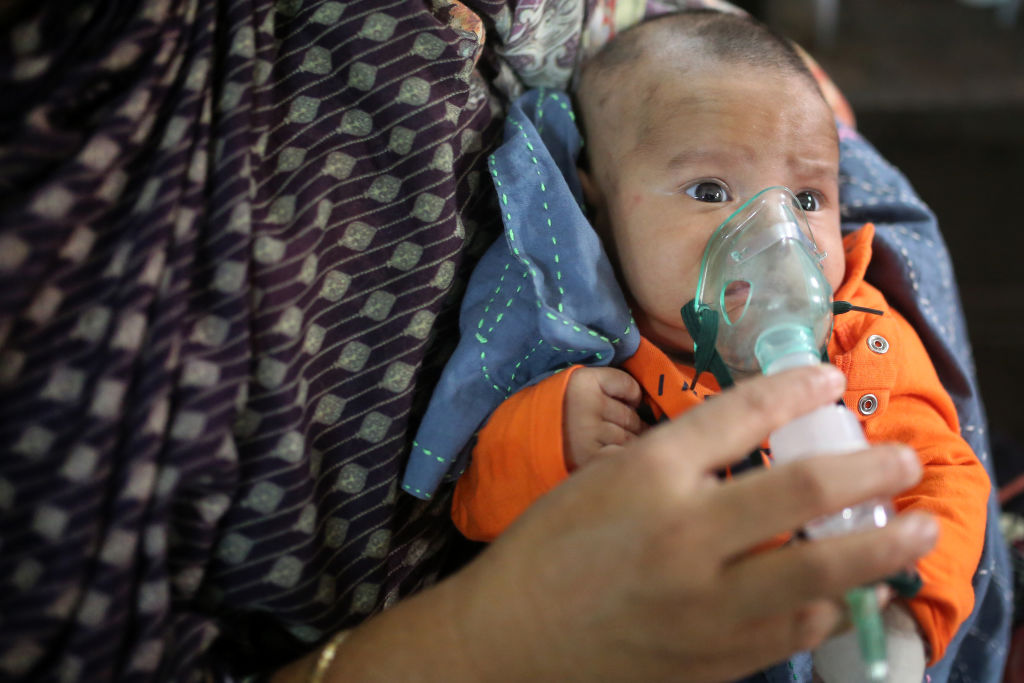
Climate change affects everyone, but especially children. Their small bodies—and the fact that they grow so rapidly, starting from the time they’re in utero—make them more vulnerable to toxins, pollution, and other climate-change fallout. Over their lifetimes, kids also face greater exposure to the damage of climate change than adults.
A new scientific review article published in the New England Journal of Medicine shows just how dangerous climate-related threats are to children’s health. The researchers analyzed data about the specific effects of a rapidly warming planet and found that climate change, driven in large part by the burning of coal, oil, and natural gas, harms children’s mental and physical health from the time they are in the womb through childhood—with potentially lifelong effects. These dangers threaten many aspects of children’s health, from the development of their lungs, to their intellectual ability, to their mental health. Socially and economically disadvantaged children are especially affected, but all children are at risk. “It’s not just polar bears on melting icebergs,” says study co-author Frederica Perera, director of the Columbia Center for Children’s Environmental Health. “There is direct harm, now, to children’s health—and certainly their future is being jeopardized in a major way.”
Policies that shift countries away from fossil fuels to renewable, more efficient sources of energy are likely to improve kids’ health, the study authors say. Health professionals should also acknowledge and learn about the health risks of climate change to better help their young patients. “We know how to do it; we know alternatives, and they’re working in different countries,” Perera says. “We just have to speed the process up…and put into effect the solutions we know work.”
Here are three big threats that stem from climate change and threaten all children around the world, according to the new research.
Polluted air
Air pollution affects children’s health in many ways. Through exposure to polluted air, children breathe in fine particulate matter created when cars, factories, and other sources burn fossil fuels. Air-pollution exposure to the fetus during a mother’s pregnancy has also been linked to low birth weight, premature births and stillbirths; scientists hypothesize that may be because air pollution can result in inflammation that makes it hard for nutrition to get to the fetus, says Dr. Aaron Bernstein, a pediatrician and interim director of the Center for Climate, Health, and the Global Environment at Harvard T.H. Chan School of Public Health (who was not involved in the new study). “Particulate pollution is a source of infant death, including stillbirth and death in infancy,” says Bernstein. Air pollution can also harm children’s lung growth and functioning, and put them at higher risk for conditions like respiratory infections, bronchitis and asthma.
Other research suggests that air pollution can adversely affect children’s minds starting in utero. An expecting mother’s exposure to air pollution particles “can be directly toxic to the developing brain” of her fetus, says Perera. “They are able to traverse the placenta.” One research review published in Cognitive and Behavioral Neurology in 2020 includes numerous studies that link exposure to air pollution to lower cognitive function in children. Other research has found associations between exposure to pollution and symptoms of anxiety and depression.
Pollutants also contribute to climate change—which, in turn, increases air pollution by fueling many of the conditions that cause wildfires, including heat and drought. And higher temperatures are thought to contribute to the development of ozone, a pollutant that harms the lungs and worsens conditions like asthma.
Less nutritious food
Climate change is undermining one of the central building blocks for growing children: healthy food. Extreme weather events that destroy food crops, including drought, flooding, and higher temperatures, are becoming more common. These can drive up the price of food and make it scarcer. Even when children have enough food, they still may not have adequate nutrients; emerging research shows that high carbon dioxide levels may make food less nutritious.
Getting enough calories and essential nutrients is central to ensuring kids grow up healthy. If kids are under-nourished, “their brains don’t develop normally,” says Bernstein. “It affects every organ.”
Global hunger is already very common and experts predict it will get worse. In 2021, about 193 million people were acutely food insecure—which the United Nations defines as food inadequacy that endangers lives or livelihoods—and about 26 million children were suffering from wasting, a condition in which kids don’t have enough weight for their height, according to the World Food Programme.
More trauma
A world altered by climate change is more dangerous for children. Famines, drought, and extreme weather events are becoming more common as a result of climate change, as are the violent interpersonal conflicts that such disasters tend to generate; for instance, climate change-driven drought is thought to have contributed to the outbreak of the 2011 war in Syria. On a hotter planet, children are more likely to be exposed to trauma, including displacement; globally, about 2.4 million children were displaced by natural disasters alone in 2021, according to UNICEF.
Living through major trauma as a child is thought to increase risk for both mental illnesses like depression as well as physical conditions such as cancer, asthma, and stroke. Stress in expecting mothers can also harm their fetus’ cognitive development.
“If your house gets burned down or flooded by a hurricane, if you’re impoverished because your family’s livelihood has been destroyed by drought—these are adverse childhood events,” says Bernstein, “and they can accumulate and exact harms across the lifespan.”
More Must-Reads from TIME
- Cybersecurity Experts Are Sounding the Alarm on DOGE
- Meet the 2025 Women of the Year
- The Harsh Truth About Disability Inclusion
- Why Do More Young Adults Have Cancer?
- Colman Domingo Leads With Radical Love
- How to Get Better at Doing Things Alone
- Michelle Zauner Stares Down the Darkness
Contact us at letters@time.com